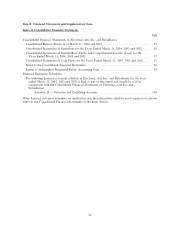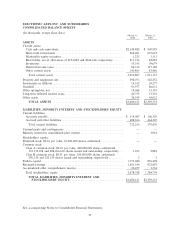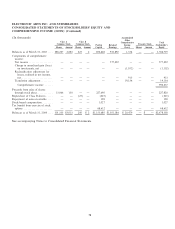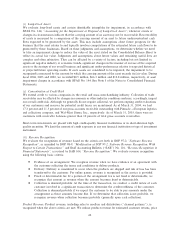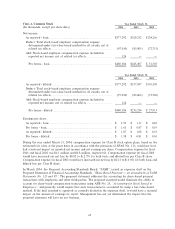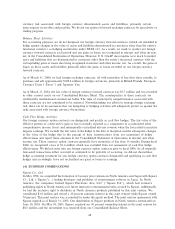Electronic Arts 2004 Annual Report Download - page 76
Download and view the complete annual report
Please find page 76 of the 2004 Electronic Arts annual report below. You can navigate through the pages in the report by either clicking on the pages listed below, or by using the keyword search tool below to find specific information within the annual report.three months and less than one year, except for certain investments with stated maturities greater than one
year that are callable within one year.
We account for investments in marketable equity and debt securities under Statement of Financial
Accounting Standards (""SFAS'') No. 115, ""Accounting for Certain Investments in Debt and Equity
Securities''. Our policy is to minimize the principal risk of our investment portfolio by earning returns based on
current interest rates. Management determines the appropriate classiÑcation of its debt and equity securities
at the time of purchase and reevaluates such designation as of each balance sheet date. Debt securities are
classiÑed as held-to-maturity when we have the positive intent and ability to hold the securities to maturity.
Securities classiÑed as held-to-maturity are carried at amortized cost, which is adjusted for amortization of
premiums and accretion of discounts to maturity. Such amortization is included in interest income. Debt
securities, not classiÑed as held-to-maturity, are classiÑed as available-for-sale and are stated at fair value.
Unrealized gains and losses are included as a separate component of accumulated other comprehensive
income (loss) in stockholders' equity, net of any tax related eÅect. Realized gains and losses are calculated
based on the speciÑc identiÑcation method. See Note 2 of the Notes to Consolidated Financial Statements.
In accordance with Accounting Principles Board Opinion (""APB'') No. 18, ""The Equity Method Of
Accounting For Investments In Common Stock'', management evaluates equity investments accounted for
under the equity and cost methods of accounting to determine if events or changes in circumstances indicate
an other-than-temporary impairment in value. We have cost and equity investments in aÇliates. Based on
several factors, such as the Ñnancial performance of the aÇliate, our decision to no longer acquire or continue
investing in these aÇliates, the limited cash Öow from future business arrangements and other information
available during Ñscal 2003, we determined that some of our investments in aÇliates contained an other-than-
temporary impairment and recorded a charge in the amount of $10.6 million to write-down these investments
to their estimated fair market value. This write-down was recorded in interest and other income, net in the
Ñscal 2003 Consolidated Statements of Operations. During Ñscal 2004 and 2002, we did not identify any
other-than-temporary impairments on our investments in aÇliates and accordingly, no charge was recorded in
our Consolidated Statements of Operations.
(g) Inventories
Inventories consist of materials and labor and include manufacturing royalties paid to the console
manufacturers. Inventories are stated at the lower of cost (Ñrst-in, Ñrst-out method) or market.
(h) Property and Equipment, Net
Property and equipment, net are stated at cost. Depreciation is calculated using the straight-line method over
the following useful lives:
Buildings ÏÏÏÏÏÏÏÏÏÏÏÏÏÏÏÏÏÏÏÏÏÏÏÏÏÏÏÏÏÏÏÏÏÏÏÏ 20 to 25 years
Computer equipment and software ÏÏÏÏÏÏÏÏÏÏÏÏÏÏ 3 to 7 years
Furniture and equipmentÏÏÏÏÏÏÏÏÏÏÏÏÏÏÏÏÏÏÏÏÏÏÏ 3 to 7 years
Leasehold improvementsÏÏÏÏÏÏÏÏÏÏÏÏÏÏÏÏÏÏÏÏÏÏÏ Lesser of the lease terms or the estimated useful lives
of the improvements, generally 1 to 10 years
Under the provisions of American Institute of CertiÑed Public Accountants Statement of Position (""SOP'')
98-1, ""Accounting for the Costs of Computer Software Developed or Obtained for Internal Use'', we capitalize
costs associated with customized internal-use software systems that have reached the application
development stage and meet recoverability tests. Such capitalized costs include external direct costs utilized
in developing or obtaining the applications and payroll and payroll-related expenses for employees who are
directly associated with the applications. Capitalization of such costs begins when the preliminary project
stage is complete and ceases at the point in which the project is substantially complete and ready for its
intended purpose. The net book value of capitalized costs associated with internal-use software amounted to
$29.9 million and $44.3 million as of March 31, 2004 and 2003, respectively, and are being depreciated on a
straight-line basis over each project's estimated useful life that ranges from three to seven years.
61





